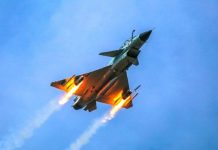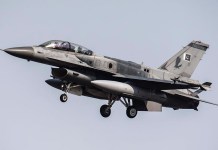During Operation Desert Storm in Iraq, the F-4G Wild Weasel was the US Air Force’s (USAF’s) dedicated fighter for suppression of enemy air defense (SEAD) operations, with updated radar and avionics converted from the F-4E. Notably, Operation Desert Storm was the first and last conflict for the F-4G.
China Can Fire Hypersonic Weapons, Conduct EMP Strikes With High-Altitude Balloons; Had Conducted Tests Back In 2017-18
According to the official history of the 1991 Persian Gulf War, F-4Gs from the 35th Tactical Fighter Wing at George Air Force Base (AFB), California, and the 52nd TFW at Spangdahlem, Germany, flew 3,942 combat sorties, fired 1,000 air-to-surface missiles, and destroyed 200 Iraqi missile sites.
These F-4Gs were deployed to Sheikh Isa AB, Bahrain, for Operation Desert Storm in 1991. They would carry AGM-88A/B/C High-Speed Anti-Radiation Missiles (HARM) and work in tandem with other F-4Gs or as a hunter aircraft directing fighter-bombers like F-16 against surface-to-air missile (SAM) sites.
The F-4G crew would comprise a pilot and an Electronic Warfare Officer (EWO), who navigated, assisted with communications, and coordinated attacks on the SAM sites.
Among the several sorties flown by F-4G Wild Weasels during Operation Desert Storm, the one flown on January 19, 1991, was truly incredible, as it dodged six surface-to-air missiles in a matter of seconds!

A detailed account of this sortie is provided in the book, ‘Magnum! The Wild Weasels in Desert Storm, by Brick Eisel, a former US Air Force (USAF) officer, and Jim Schreiner, a former F-4G pilot from the 561st Tactical Fighter Squadron at George Air Force Base (AFB), who was a part of this sortie.
Schreiner and his backseater, Dan Sharp, were flying a four-ship F-4G sortie which included an aircraft piloted by Major Steve ‘Teach’ Jenni and Electronic Warfare Officer (EWO), Captain Mark ‘Gucci’ Buccigrossi, with the two aircraft using the call signs, Longhorn 31 and Longhorn 32, respectively.
The mission for the flight was to provide direct support for a cell of B-52 bombers dropping some fifty-four bombs weighing 750 lb (340.194 kilograms) each on one of the dug-in positions of the Republican Guard armored divisions.
The B-52 Stratofortress was nicknamed the BUFF since the days of the Vietnam War. Nearly a dozen B-52s were shot down or damaged by Soviet-made S-75 Dvina (NATO reporting name SA-2 Guideline) high-altitude air defense systems fielded by North Vietnam.
Therefore, the USAF planners for Desert Storm wanted to ensure that the bombers were well protected this time.
So, the Longhorn flight was supposed to go ahead of the BUFFs and destroy the ‘lethal’ SA-2s and any other SAMs that had the range and reach to hit the bombers.
“It was a high priority, do or die mission for the Weasels,” Eisel explains in the book.
Schreiner and Sharp had experienced a failure of the digital ARN-101 navigation system of their F-4G during the previous sortie, so they had to switch two spare jets, which delayed their as well as Jenni and Buccigrossi’s take-off.
Schreiner recalls, “3 & 4 were long gone, and lead, tired of waiting for us, decided to take off without us. I could tell he was pissed because as he taxied by, he twirled his hand above his helmet, telling us to hurry up. At the time, he didn’t realize we were on our third jet.”
Nevertheless, Schreiner completed the pre-fight procedures rapidly and got the jet running.
“Fortunately, everything worked, and we were out of the chocks in record time. I called the tower for take-off clearance and was told to wait for three aircraft landing. The last one was an emergency and might take the barrier and close the runway. Luckily, he didn’t, and we were off, but twenty minutes late,” Schreiner wrote.
Schreiner flew toward the tanker as fast as possible without using the afterburner, with a considerable payload other than the HARM missiles and three external fuel tanks of 1000 gallons each.
After getting re-fuelled by the tanker, which Schreiner describes as “a little sporty” because of the tanker flying in and out of a cloud layer, he proceeded directly to the target area.
Schreiner and Sharp could make it to the target area within their target time and join the flight.
The Missiles Start Coming In From All Directions
Eisel explains that Buccigrossi detected an SA-2 short of the BUFF’s intended target, and realizing the need to deal with this threat while not wanting to leave the bombers completely unprotected, he directed that Longhorn 32 should deal with the threat.
“We picked up the SA-2’s signal in search mode and then rapidly switched to targeting. We then pickled a HARM at it,” said Buccigrossi.
Schreiner’s view of this event was, “At the TOT (time on target) for the BUFFs, we saw many explosions on the ground as they salvoed.” The TOT is a military technique to ensure that all munitions fired by multiple platforms arrive at the target roughly simultaneously.
At the same time, Schreiner and Sharp also picked up strong, reliable indications of SA-2 SAM from their APR-47 radar warning receiver (RWR), which Schreiner describes as going “from range unknown to range is known to track indications to a firing indication in about as much time as it takes to read this sentence.”
He further says that they did not shoot at the SAM because Longhorn 32 was working on its signal, although, in retrospect, he believes that they should have shot at it. After all, it was the only chance they would have.
Buccigrossi continues his part of the story, describing how they were at medium altitude at around 350 knots and a cloud base about 1,800-2,000 feet above ground level. They picked up an orange glow below the cloud deck at nine o’clock.
Popping through that layer of cloud, they saw two SA-2 SAMs tracking toward them, after which Teach rolled the jet, and Buccigrossi released chaff and hit the switches for the electronic counter-measures (ECM) pod.
“Both missiles continued towards our six o’clock but climbed while we descended fairly rapidly. I watched the missiles explode behind us,” said Buccigrossi.
According to Eisel, seconds after avoiding the pair of SAMs, the Longhorn flight spotted the second pair of missiles coming toward them. They also evaded those SAMs by trading altitude and airspace for distance from the warheads. The missiles were guided just behind them and detonated with no damage to their F-4G.
“Immediately after those two exploded, we saw a third set on our left side, so away we went again, down and around, to avoid these guys. The missiles couldn’t turn hard enough to stay with us, so for the third time in about ninety seconds, they tracked behind us and exploded,” Buccigrossi continued.
According to Buccigrossi, in less than two minutes, they had avoided six SAMs and made that particular SAM site shoot all of its missiles, because of which, they could not fire again at the BUFFs until after reloading, which would take them long.
However, with all that turning and burning, the Longhorn 32 had dropped into the principal range of hostile anti-aircraft artillery.
“I looked down at our gauges and saw that we were below 10,000 feet and under 300 knots. I told Teach to climb or speed up, and he said, ‘I’m working on it,'” Buccigrossi recalls.

Meanwhile, Schreiner, much to his surprise, saw another set of SA-2 missiles headed toward them. He immediately selected the afterburner, rolled the aircraft inverted, and pulled while keeping the SA-2s aligned with the aircraft.
Initially, he was at somewhere around 25,000 feet, and eventually, he leveled at about 10,000 feet, and while at it, he told Sharp to hit the chaff and ECM pod. “The combination of all three did the trick because one by one, I watched them arc harmlessly away and self-destruct at the end of their life,” said Schreiner.
After that, Schreiner began ascending again to deal with the SAM site that had fired the missiles upon them.
The Longhorn 31 was short on gas after having used up a lot while evading six SAMs, and with only one tank aboard, it could no longer hang around. So, Teach and Buccigrossi returned to base, flying due south into Saudi Arabia, where they landed at a base, got gas, and flew back to Sheikh Isa.
Meanwhile, Schreiner and Sharp, having taken the spare configured with three tanks, had more gas and stayed in the area, even after the BUFFs had departed, to try and neutralize the SA-2 site that had taken them by surprise. They landed at Sheikh Isa at around 0315.
For their efforts in protecting the B-52s and a remarkable feat of having evaded six SA-2s in those few seconds, (then) Major Steve Jenny and Captain Mark Buccigrossi were awarded the Silver Star, the third-highest military decoration for valor in combat.
- Contact the author at tanmaykadam700@gmail.com
- Follow EurAsian Times on Google News




